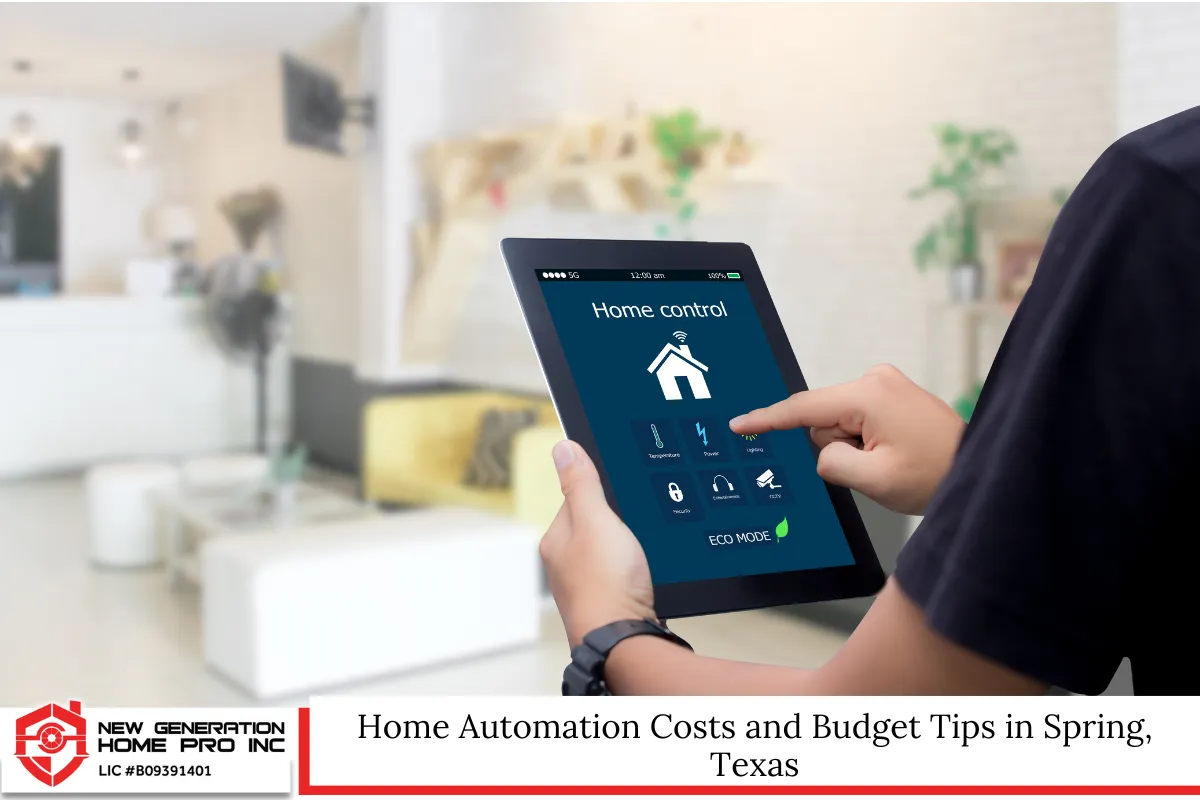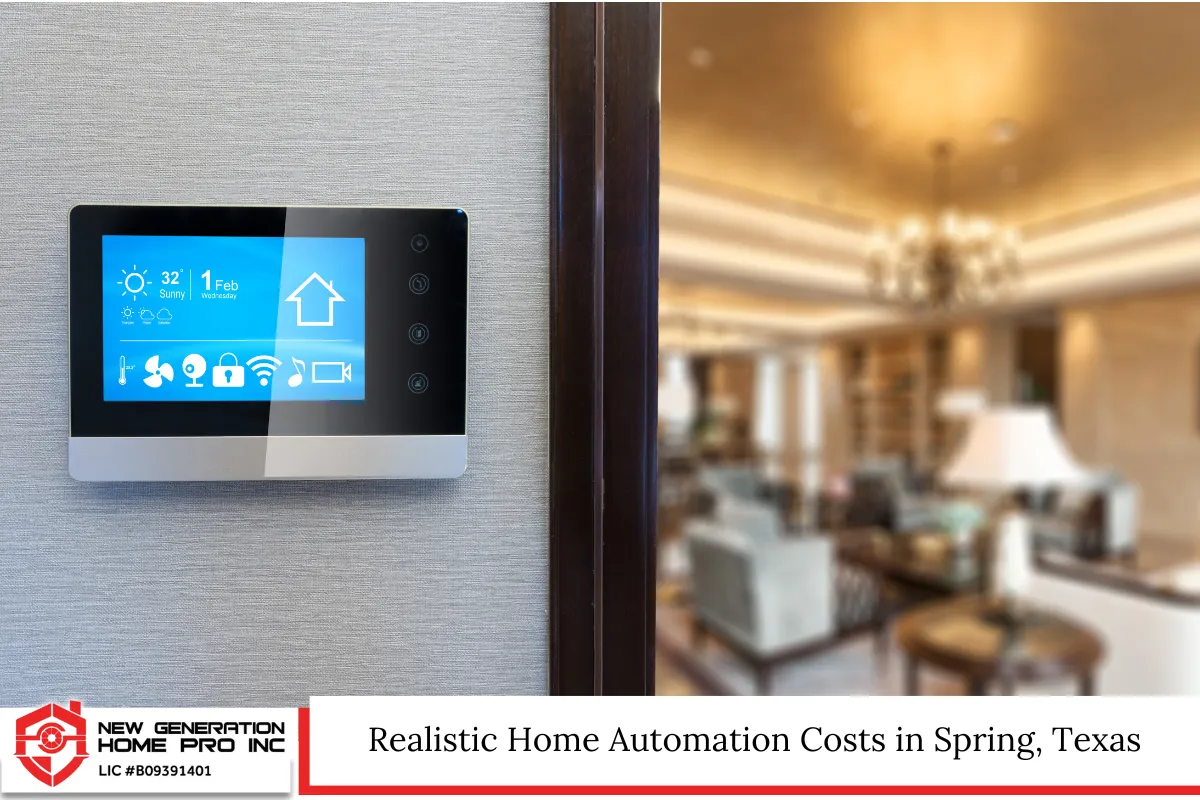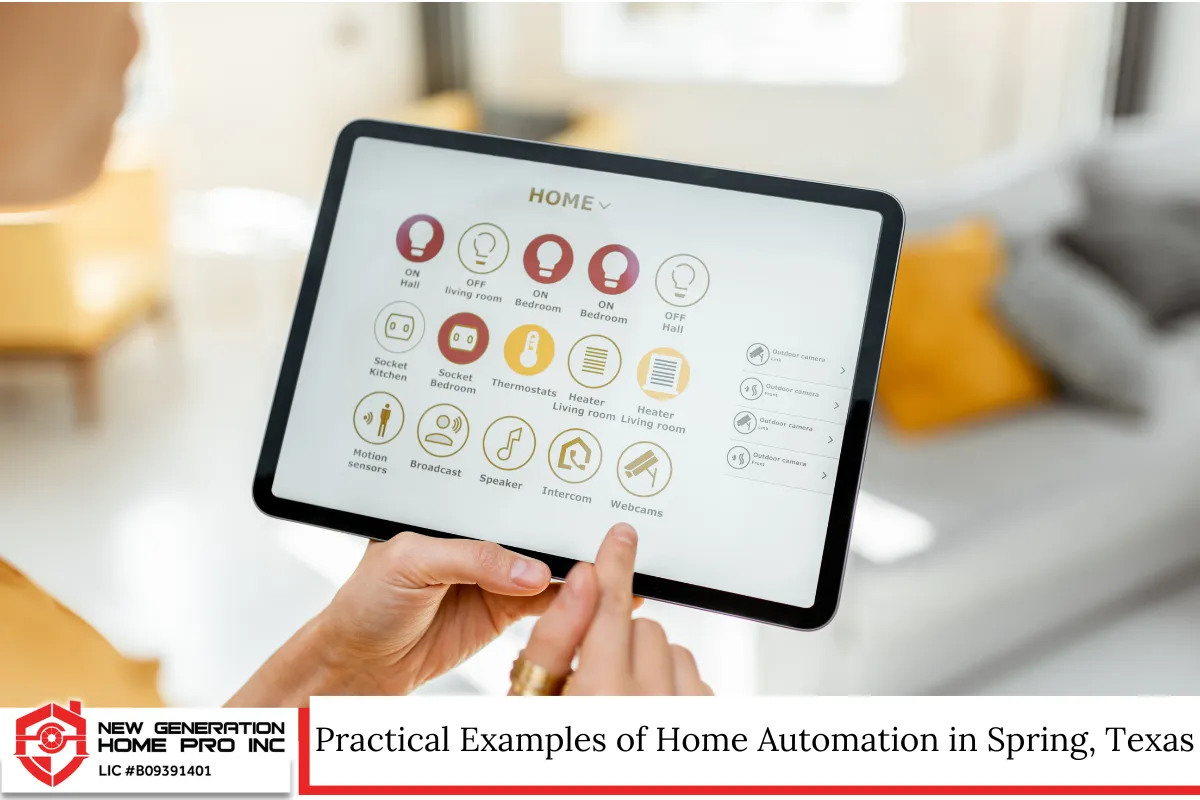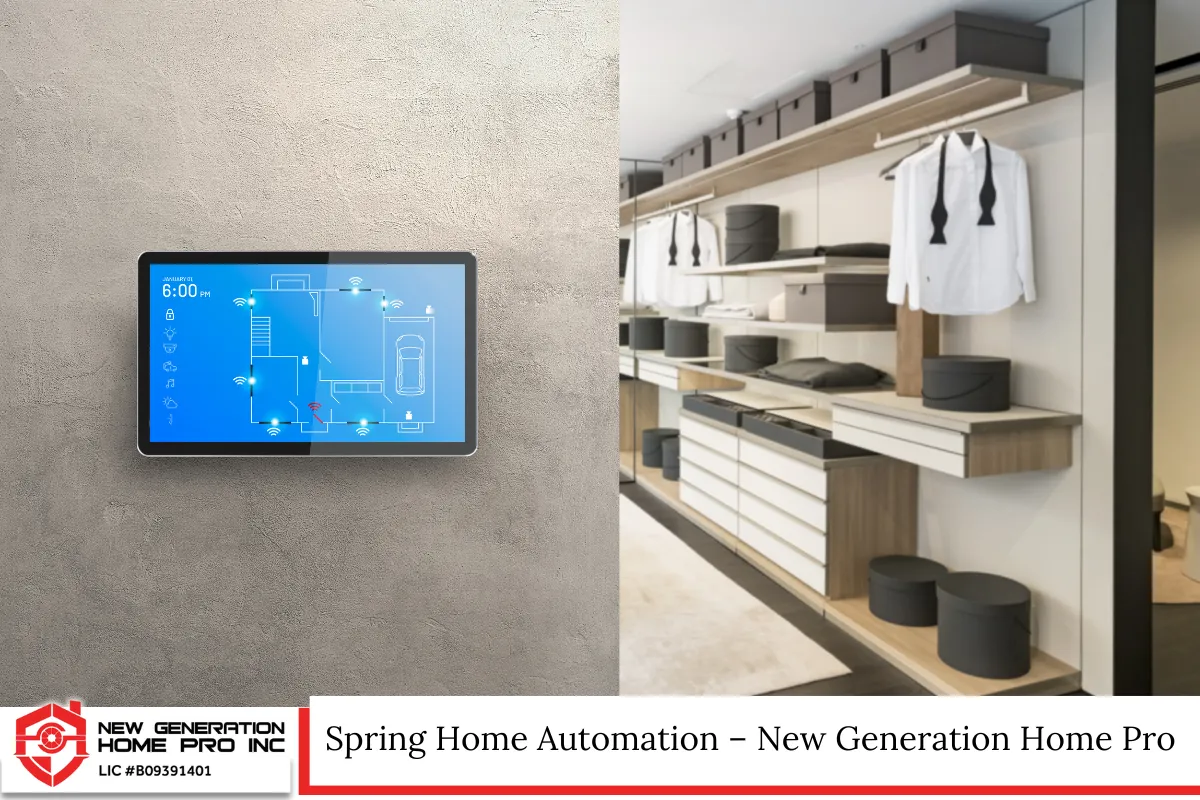 Home automation is becoming more than just a modern luxury—it’s now a practical way to enhance comfort, improve safety, and manage daily tasks more efficiently. In Spring, Texas, families and homeowners are increasingly turning to smart technology to create more convenient living spaces. From smart thermostats that adjust to your daily habits to security systems that alert you to activity in real time, the options for automating your home are both exciting and extensive.
Home automation is becoming more than just a modern luxury—it’s now a practical way to enhance comfort, improve safety, and manage daily tasks more efficiently. In Spring, Texas, families and homeowners are increasingly turning to smart technology to create more convenient living spaces. From smart thermostats that adjust to your daily habits to security systems that alert you to activity in real time, the options for automating your home are both exciting and extensive.
Understanding the costs involved in home automation can help you plan more effectively and avoid unexpected expenses. Whether you’re upgrading a few devices or building a fully integrated smart home, this article will guide you through typical expenses, budgeting strategies, and how to make informed decisions about bringing smart tech into your home in Spring, TX.
Understanding Home Automation: What It Means
Home automation refers to the integration of technology that enables you to control various aspects of your home remotely or automatically through devices such as smartphones, tablets, or voice assistants. This includes lighting, climate control, security systems, appliances, and other essential components.
In practical terms, home automation can range from using a smart plug to control a lamp to programming your entire home to follow a specific routine. For instance, lights can turn off automatically when no one is in a room, or the thermostat can adjust based on whether you’re at home or away. The systems are typically controlled through a central app, and many also integrate with voice-activated systems, such as Google Assistant, Siri, or Alexa.
The purpose of home automation is to increase energy efficiency, add convenience, and improve the overall security of your home. In Spring, Texas, this technology is becoming especially relevant due to the seasonal temperature changes and growing emphasis on home safety.
Realistic Home Automation Costs in Spring, Texas

Understanding the cost of home automation is essential before making any purchases. Costs vary based on the complexity of the system, the brand of the products, and whether installation is done professionally or through DIY efforts.
Basic Setup Costs
For homeowners who want to dip their toes into automation, a basic setup typically includes a smart speaker, a few smart light bulbs, and possibly a smart plug or two. These entry-level devices can give you a feel for how automation works without requiring a major investment.
Prices for basic devices typically fall within these ranges:
- Smart bulbs: $15–$50 each
- Smart plugs: $20–$40 each
- Voice-controlled assistants (like Echo Dot): $30–$100
- Basic smart thermostat: $100–$200
Starting small costs between $300 and $700, depending on the brand and number of devices you choose.
Intermediate System Costs
As your home automation needs grow, consider adding smart door locks, video doorbells, or advanced thermostats to enhance your home’s security and comfort. These systems offer more control and typically require a stronger Wi-Fi network or an automation hub to manage everything smoothly.
Additional costs may include:
- Smart locks: $120–$300 each
- Video doorbells: $130–$250
- Outdoor security cameras: $150–$500 per unit
- Smart switches and dimmers: $40–$70 each
An intermediate-level setup usually ranges from $1,000 to $3,000. This level of automation offers noticeable improvements in energy savings, security, and lifestyle convenience.
Advanced or Whole-Home Automation Costs
At the high end of the scale, complete home automation systems can include centralized control hubs, professional installation, customized routines, and seamless integration of multiple smart devices. These setups may involve:
- Smart HVAC systems with zoning controls
- Multi-room audio setups
- Motorized window coverings
- Whole-house lighting automation
- Security systems with motion detection and real-time alerts
Installing a high-end, fully integrated system typically costs $5,000 to $20,000 or more. These systems are often designed and installed by professionals to ensure flawless operation across every room.
Key Factors That Influence Home Automation Expenses

The cost of home automation doesn’t just depend on what devices you buy. Several other factors can impact your budget and the long-term value of your investment.
Type of Installation
Installing automation devices yourself is usually more affordable, especially if you’re tech-savvy and comfortable following setup guides. On the other hand, professional installation provides a smoother experience and ensures that everything works together. In Spring, TX, hiring a licensed installer can cost around $100 to $150 per hour.
Size of Your Home
Larger homes naturally require more equipment. For example, a small home might only need two security cameras. In contrast, a larger property may need six or more to cover entrances, driveways, and backyards. The number of rooms also impacts how many smart switches, sensors, and thermostats you’ll need.
Internet and Network Requirements
Home automation systems rely on a strong and stable internet connection. Larger homes in Spring may require a mesh Wi-Fi system to ensure comprehensive coverage throughout all areas. These systems can cost between $200 and $500, depending on the number of access points required.
Integration and Compatibility
Mixing and matching products from different brands can lead to compatibility issues. Sticking with a single ecosystem—like Google Nest, Amazon Alexa, or Apple HomeKit—can help avoid technical headaches and often makes setup easier.
Best Practices for Budgeting Your Smart Home in Spring, TX
Creating a home automation system doesn’t have to happen all at once. With the right budgeting strategy, you can build a smart home gradually while still enjoying the benefits along the way.
Start with High-Impact Areas
Focus first on the rooms or devices that will make the biggest difference in your daily life. Popular starting points include front doors (smart locks), living rooms (smart lighting), and climate control (smart thermostats). These changes often deliver immediate comfort and energy savings.
Set a Monthly or Quarterly Tech Budget
Instead of buying everything at once, set a monthly or quarterly spending limit. This lets you upgrade consistently without straining your finances.
Take Advantage of Sales and Rebates
Retailers in Spring often offer discounts on smart devices during major sales events, such as Memorial Day, Labor Day, and holiday weekends. Some energy-efficient devices may also qualify for utility rebates.
Plan for Future Expansion
Even if you’re starting small, choose expandable devices. For example, smart hubs that support multiple device types allow you to build your system without needing to replace anything later.
Practical Examples of Home Automation in Spring, Texas

In Spring, Texas, the climate and lifestyle present unique opportunities for smart home integration. Here’s how home automation fits into everyday living in this region.
Climate Control
Summers in Spring can get hot and humid. A smart thermostat can adjust your home’s temperature according to your schedule, helping to reduce energy costs while maintaining a comfortable indoor environment. Some models even learn your habits over time and make automatic adjustments to improve efficiency.
Outdoor Security
With the rise of suburban neighborhoods, many residents prioritize exterior security. Outdoor cameras with motion alerts and night vision help monitor driveways, porches, and yards. Combined with smart doorbells, these tools enhance safety and awareness.
Smart Irrigation Systems
Lawns and gardens in the Spring need regular care, especially during the warmer months. Smart sprinkler systems monitor weather forecasts and soil moisture, watering plants only when necessary, thereby helping to conserve water and save money.
Common Mistakes to Avoid with Home Automation
Planning and research are key when setting up home automation. Here are a few mistakes to watch out for:
Overbuying Early
Buying too many devices at once can lead to unnecessary expenses and complications. It’s better to start with a few essential items and expand as needed, based on your experience and requirements.
Ignoring Network Strength
All smart devices rely on your internet connection. Without strong Wi-Fi coverage, especially in larger homes, you may run into connection drops or device failures.
Mixing Incompatible Systems
Using devices that don’t communicate well with each other can lead to frustration. Stick with compatible products or invest in a reliable home automation hub that bridges different ecosystems.
Skipping Updates and Security Settings
Smart devices receive regular firmware updates that improve performance and security. Be sure to enable automatic updates and change default passwords to keep your system protected.
Bringing It All Together with a Long-Term Vision
Home automation is not just about convenience—it’s an investment in a smarter, more efficient way of living. In Spring, Texas, where seasonal weather changes and family-focused lifestyles shape how people interact with their homes, automation offers solutions that adapt to everyday needs.
Creating a home automation system doesn’t mean you need to spend a fortune all at once. With careful planning, a clear budget, and the right tools, you can create a system that grows with your home and enhances your lifestyle in meaningful ways.
Spring Home Automation – New Generation Home Pro Inc

Home automation helps Spring, Texas, residents stay in control of their homes with less effort. From adjusting lights and temperature to monitoring your property around the clock, these systems make everyday living easier and more secure. It’s a smart way to protect what matters and enjoy more comfort at home.
New Generation Home Pro Inc. offers reliable home automation solutions designed for both residential and commercial properties in Spring. We install alarm systems, security cameras, and smart devices that give you 24/7 monitoring with clear two-way voice communication. Everything is designed to fit your lifestyle and provide you with peace of mind. Call us at (713) 501-9985 to learn more and see how easy it is to upgrade your home!
Frequently Asked Questions About Home Automation in Spring, TX
How does smart home automation work with voice assistants and remote controls?
Smart home automation works by connecting various devices—like lights, thermostats, and appliances—into a centralized system that can be controlled through voice assistants or remote controls. Devices such as Amazon Alexa, Google Assistant, or Siri on Apple devices recognize voice commands to turn on lights, adjust the temperature, or activate home security settings.
Most smart homes rely on a smart home hub, also known as a central hub, to communicate with all the connected devices. This hub processes commands and sends them to the appropriate device using wireless protocols such as Zigbee, Z-Wave, or Wi-Fi. For instance:
- Say, “Turn off the lights” – your smart bulbs will respond.
- Use a smartphone app to remotely control your lighting and motion sensors.
- Automate schedules – set lights to turn on at sunset or your smart refrigerator to lower power mode overnight.
Voice control and remote access bring convenience, especially in daily routines like arriving home or heading to bed.
Can home automation increase property value in Spring, Texas?
Yes, smart home technology can increase property value, especially in a growing and competitive market like Spring, TX. Many buyers now seek homes with integrated smart features that offer energy savings, convenience, and enhanced safety.
Adding devices like smart security cameras, motion sensors, and surveillance cameras can make a property more appealing, particularly to families and professionals concerned with home security. Likewise, smart bulbs, programmable thermostats, and home entertainment systems are seen as valuable upgrades.
Here’s how smart systems can influence value:
- Energy efficiency – lower utility costs attract eco-conscious buyers.
- Security features – peace of mind is a huge selling point.
- Modern appeal – tech-ready homes feel future-proof.
- Convenience – being able to use a voice assistant or remote controls adds daily comfort.
Even relatively simple setups, such as a smart thermostat or a lighting system, can significantly boost resale value and make a listing stand out.
Do I need a smart home hub to integrate all my home systems?
While not always required, a smart home hub or central hub is highly recommended if you want all your home systems to work seamlessly. A hub acts as the brain of your smart home. It connects different devices—even from different brands—so they can communicate and work as one unified system.
Without a hub, you may have to use multiple apps to control each device separately, which can be inconvenient. With a hub, you can:
- Create automated scenes, such as “Movie Night,” to dim smart bulbs and start your home entertainment system.
- Sync lighting controls with motion sensors for energy efficiency.
- Use a single dashboard or app to monitor your smart security cameras and surveillance cameras.
Smart hubs support wireless protocols like Zigbee or Z-Wave, which are often more reliable than Wi-Fi. They also make it easier to install software updates, manage settings, and keep your smart home secure and up to date.
How often should I update my smart home devices and software?
Regular software updates are crucial for maintaining the security, reliability, and compatibility of your smart home technology with the latest features. Most modern smart devices—such as smart refrigerators, smart security cameras, and voice assistants—receive over-the-air updates directly from the manufacturer.
Here’s a general guideline for updates:
- Automatic updates: Enable them in your settings whenever possible.
- Manual checks: Check the app every 1–2 months if automatic updates are disabled.
- Security patches: Install immediately to protect against new threats.
- Feature upgrades: Stay current to benefit from voice command enhancements or new integrations.
Updating your home automation software helps fix bugs, improves performance, and ensures continued compatibility across devices using wireless protocols like Zigbee or Wi-Fi. It’s also critical for devices connected to your smart home hub, as outdated firmware can cause communication issues and system slowdowns.
Always back up settings where applicable and follow the manufacturer’s instructions during each update.
What are the must-have home automation features for better home security?
For stronger home security, certain smart home automation features are especially effective and worth investing in. These devices help monitor activity around your property and alert you to any suspicious movement in real time, giving you peace of mind.
Key features include:
- Smart security cameras – stream live video and send motion alerts.
- Motion sensors – detect unusual movement and trigger alarms or lights.
- Voice assistants – use voice command to arm or disarm your system.
- Surveillance cameras monitor key areas, such as entrances, driveways, and backyards.
- Smart locks – control door access remotely.
- Lighting controls – schedule lights to mimic occupancy while you’re away.
Spring homeowners often use a central hub to link all these systems, allowing full control through a single interface. Combined with remote controls, these tools make it easy to respond quickly to potential threats—even if you’re not at home. Proper setup also boosts property value over time.
Read more: Top Home Automation Devices for Beginners in Spring, Texas





